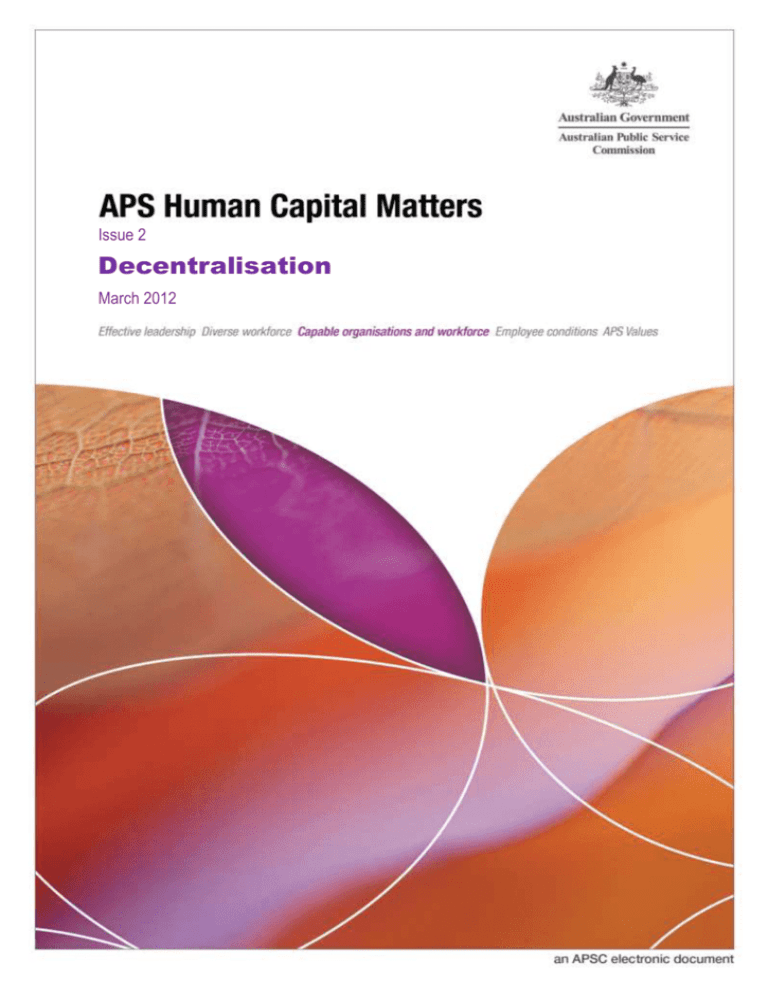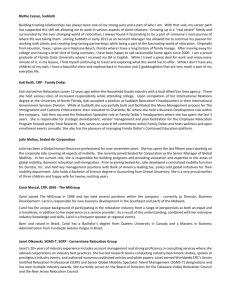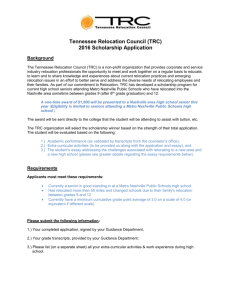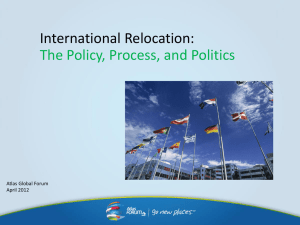Proposed Digest of Journal Articles for Public SES
advertisement

Issue 2 Decentralisation March 2012 APS Human Capital Matters: Decentralisation March 2013, Issue 2 Editor’s Note to Readers Welcome to the second edition of Human Capital Matters for 2013—the digest for time poor leaders and practitioners with an interest in human capital and organisational capability. This edition discusses the relocation of government agencies away from the Centre to the regions and the ‘virtual’ issues and challenges this raises for managers. Decentralisation has been a fact of public sector life for some time, with the most ambitious and numerically successful relocations occurring in the UK, going back to 1963. In that year, Sir Gilbert Flemming’s review recommended the relocation of 57,000 jobs out of London. The next such review, undertaken in 1973, recommended the dispersal of 31,500 positions, although only around 10,000 of these were ever relocated. The Next Steps program of the late 1980s and 1990s saw 19,000 posts relocated or established outside the South East between 1989 and 1993. More recently there has been substantial impetus given to relocation in the UK by the Blair and Brown Labour Governments which has been reconfirmed by the Coalition Government elected in May 2010. So that by December 2009, over 21,500 public sector jobs had been moved out of London and the UK Budget Papers for 2010 (the first Coalition Budget) outlined the Government’s intention to relocate a further 15,000 civil service jobs out of central London by 2015. Relocation is also occurring in the Republic of Ireland and Northern Ireland; it was announced in 2012, that the relocation of the headquarters of Northern Ireland’s Agriculture Department to Ballykelly would mean the movement of 800 positions to the North West. Other jurisdictions which have also engaged in relocation in order to improve national government, social and economic outcomes over the past two decades include France, Germany, Norway, Japan and Canada (notably, British Columbia). For many, the primary reason for relocating away from the Centre is because ‘…the geographical decentralisation of the civil and public service is seen as an opportunity to secure improved efficiency on the back of business process re-engineering (BPR), new working practices and modernisation.’1 But there is a much broader range of benefits that accrue as a result of decentralisation, particularly to the communities into which government employees are relocated; this is a theme of a number of the papers in this edition of Human Capital Matters. The report completed by Sir Michael Lyons in 2004 on the relocation of government employees in the UK articulated the range of benefits that accrue from the relocation of Government services. The Experian report commissioned as part of the larger Lyons report specifically identified some of the benefits that can accrue to the regions into which public sector employees are relocated. While a little dated these papers still resonate today. The policy implications of public sector relocation in Northern Ireland were described in a review chaired by Sir George Bain in 2008, many of which are applicable across a range of jurisdictions. Le Goff’s study of relocation in Canada found that, to be successful, public sector relocation programs must be based on the needs of sound governance and public sector employees rather than private sector lobby groups. Finally, Ian Smith’s 2010 report focuses on the savings to taxpayers of relocation while recognising the broader outcomes of relocation Peter C. Humphreys and Orla O’Donnell, Public Service Decentralisation: Governance Opportunities and Challenges, Institute of Public Administration, Dublin, 2006, p. xi. 1 2 including economic stimulation, bringing government closer to the people and promoting a more efficient public service. But decentralisation is not without its management challenges, most of which centre on dealing with a dispersed workforce. The paper by Hansen et al highlights that many of the challenges facing dispersed teams can also occur in a collocated team, but are exacerbated in a dispersed team. Finally, Ware and Grantham provide some very practical outcomes from their research into the factors needed to manage remote workers successfully. As a special bonus, readers might also like to look at Gerard McManus’s very short article in the Australian Institute of Management’s Management Today (March 2013, pp. 24–25) which provides 21 tips on how managers can keep remote employees motivated and connected. Happy reading! About Human Capital Matters Human Capital Matters seeks to provide APS leaders and practitioners with easy access to the issues of contemporary importance in public and private sector human capital and organisational capability. It has been designed to provide interested readers with a monthly guide to the national and international ideas that are shaping human capital thinking and practice. Comments and suggestions welcome Thank you to those who took the time to provide feedback on earlier editions of Human Capital Matters. Comments, suggestions or questions regarding this publication are always welcome and should be addressed to: humancapitalmatters@apsc.gov.au. Readers can also subscribe to the mailing list through this email address. 3 Experian, The Impact of Relocation, January 2004, London, 81 pp. This report was commissioned by Sir Michael Lyons during the course of his major inquiry into the relocation of government agencies from London and the South East (see abstract for Sir Michael Lyons). It looks at public and private sector relocations across the UK, and examines the economic impact of public sector relocation. It is based largely on a series of interviews with the senior staff of 10 public sector bodies and the leaders of seven companies as well as a number of case studies. Experian concluded that, ‘… relocation brings significant benefits to organisations, enabling them to reduce operating costs, reshape their culture, and modernise working practices in the light of new technology’ (p. 1). The study also reported that, ‘ … the economic benefit to areas receiving relocated government functions was greater than had been believed, and that there were broader, but less tangible benefits to these areas in terms of boosting skills and investment, and building confidence for future development and investment’ (p. 1). On the basis of this work and a literature search, it reached seven specific conclusions about the relocation of government agencies which still have resonance today: 1. Relocation can deliver considerable cost benefits, principally in the areas of premises costs and labour costs. 2. Relocations that focus on delivering operational change are likely to deliver greater benefits than those that focus exclusively on labour and rental cost savings. 3. Organisations can benefit from improved labour force availability and better service delivery. 4. Relocation can in some instances significantly advance wider Government imperatives, such as regional growth, regeneration and devolution. 5. Effective planning and project management are required in order to facilitate a successful move. 6. Relocation benefits must be sustained; long-term success requires careful risk management and, critically, strong leadership and commitment from the top. 7. The debate as to whether or not ‘policy’ people can move from London will benefit from much tighter definition and challenge; ‘policy’ and other senior jobs have been successfully relocated in the past. Experian (whose Business Strategies Division produced this report) is an information services company operating in 44 countries. Tine S. Hansen, Alexander Hope and Robert C. Moehler, ‘Managing Geographically Dispersed Teams: From Temporary to Permanent Global Virtual Teams’ (‘Built and Natural Environment Research Paper’), Northumbria University, Newcastle upon Tyne, 2012, 16 pp. The authors note that the rise and spread of ICT has enabled increasing use of geographically dispersed work teams (Global Virtual Teams), and that originally these were mainly organised for the purpose of undertaking temporary projects. However, they add that little research has focused on the emergent challenge for organisations to move towards establishing more enduring Global Virtual Team structures in order to leverage knowledge sharing and cooperation across distance. To close this gap, the paper provides the outline of a research project designed to assist organisations in doing so. The authors observe that new factors and influences are shaping virtual work: the parameters in relation to increasing global competition have changed; a new generation of self-motivated employees who are already practising virtual relationships has emerged and is currently joining the global workforce; and the constant improvement in ICT. 4 As the authors make clear working together over distance presents a number of challenges. These may also be found in colocated teams, but they are almost invariably magnified due to dispersion and involve issues of trust; coordination of work; conflict; culture; and ICT. The task of building Global Virtual Teams, however, has been assisted by two developments related to rapid and global ICT expansion. The first concerns recruitment of Generation Y employees or the Millenium Generation (those born between 1977 and 1998) who are highly skilled at virtual work. Many of these employees also fall within the category of so-called ‘native speakers’ of the digital language of computers, video games and the Internet. Hitherto, one of the main Global Virtual Team foci has been enhancing organisational flexibility and speed by leveraging specialist skills. The authors argue, however, that in the future organisations will come increasingly to rely on building permanent Global Teams due largely to increasing globalisation and the need to outsource and build networks with partners to a greater degree than in the past. They conclude by suggesting a number of areas for possible future research concerning the extent to which organisations work via Global Virtual Teams. These include preparation for working in such teams; the staffing of teams; and how Millenials entering an organisation shape its approaches to Global Virtual Team activity. Tine S. Hansen is based at the School of Technology and Business, VIA University College, Denmark; Alexander Hope and Robert Moehler lecture in the School of the Built and Natural Environment, Northumbria University, Newcastle upon Tyne. Independent Review of Policy on Location of Public Sector Jobs, Report (Chairman: Sir George Bain), HMSO, Belfast and London, 2008, 220 pp. The review team, appointed in December 2007, was asked to devise ‘an agenda for action’ and ‘a set of practical recommendations for the longer-term approach to the location of public sector jobs’ in Northern Ireland. The authors begin (Chapter 1) by noting the increasing attention given in recent years, both nationally and internationally, to the relocation of public sector jobs from capital cities. In Chapter 2, they discuss the broader context for relocation by focusing on the role that relocation might play in regional regeneration of Northern Ireland’s depressed areas and in helping to rebuild deteriorating infrastructure. The public sector in Northern Ireland accounts for 31% of employee jobs and 13% of the overall population (of all ages), figures higher than the comparable ones for the UK overall and the Republic of Ireland. Many public servants travel from remote areas to work in Belfast at considerable economic and other costs to themselves. Chapter 3 looks at how these pressures could be eased. In Chapter 4, the authors discuss the three main reasons for relocation as revealed in the literature on the subject: enhancing the delivery of effective public services; promoting more balanced regional economic development and reducing social deprivation; and promoting sustainability. They add that relocation provides a catalyst to maximise the potential of technology and can be a fillip to the adoption of new working practices, thus creating greater effectiveness and efficiency. Chapter 5 of the study outlines the experience of relocation in Northern Ireland, the Republic of Ireland, Wales, England and Scotland. The review team concludes that the extent to which it has been able to draw conclusions on the subject has been largely determined by the degree of maturity of the various relocation strategies. Scotland’s, for example, is nine years old and is therefore easy to assess. They also observe that the recent English experience demonstrates the success that can be achieved where a clear and measurable objective (to reduce costs) is set from the outset, and the right environment (regional cost disparities) exists to achieve this objective. They also note that in all these jurisdictions the physical relocation of people gives rise to significant human resource and industrial relations issues. The study argues (Chapter 6) that flexible working arrangements based on the innovative use of ICT are the key to successful 5 relocation. In Chapters 7 and 8, the authors propose a relocation program for Northern Ireland and make 27 recommendations (pp. 19–22) for doing so. A number of these could be implemented in other jurisdictions. They include: 1. Relocations should be implemented in a phased approach over a period of, say, five years (Recommendation 10). 2. Relocation should be considered in the event of the restructuring of government departments, lease breaks, and where opportunities exist to enhance service delivery, to cluster services or to colocate services (Recommendation 17). 3. Clear objectives and benefits-realisation plans should be developed at the outset of relocation projects as part of the business case (Recommendation 23). 4. A small central unit should be set up to provide direction, oversight, and support on relocation (Recommendation 26). The eight members of the review team were drawn from the public and private sectors and emphasise that they do not represent any particular interest or point of view: ‘ … we bring experience to the table, not representation.’ Philippe Le Goff, Moving Public Servants to the Regions, Parliament of Canada, Ottawa, March 2005, 6 pp. The author notes that the idea of moving public servants out of Ottawa into the regions was first mooted in the mid-1970s. An ambitious relocation program had been embarked upon by the Canadian Government in order to promote national unity, regional economic development, balanced urban growth and enhanced delivery of services. Some 10,000 positions were identified for relocation to 24 different cities. However, the project was discontinued in the early 1980s, largely on the grounds of cost and in the face of employee opposition. In 2005, however, the Government announced that three small agencies would be relocated and these moves took place. After discussing how Canadian Government jobs are distributed across the country, the author goes on to identify the strengths and weaknesses of relocation. He concludes by proposing the establishment of a rigorous and transparent analytical framework that might help to maximise the positive impact of spreading federal jobs across Canada and reduce the arbitrariness— whether real or perceived—which in the past has sometimes been associated with relocation. The author notes the USA federal public service’s high degree of decentralisation (in 2002, for example, only 16.6% of federal jobs were concentrated in (and near) Washington, DC). The figure for the UK (in 2004) was 16.6%—excluding military personnel). In 2005, some 35% of Australian Public Service staff was located in Canberra. In the same year in Canada, 31% of federal government employees worked in the National Capital Region in (and around) OttawaGatineau. The author concludes that the degree to which federal jobs are spread across a country seems to depend greatly on demographic and economic imperatives. He cites a number of reasons for relocation: first and foremost, regional development; secondly, lower operating costs in the regions; thirdly, distributing growth and creating synergies to maximise the effectiveness of public spending; and, finally, bringing federal jobs closer to pools of available workers in order to alleviate the impact of an ageing public service. The author also outlines a number of arguments against relocation: high short-term human resources and materiel costs; disruption of the community structure with the coming of a large number of public servants who may enjoy higher salaries than local residents do; and unexpected and high costs of public servants travelling across a vast country like Canada on official business (assuming that teleconferencing cannot meet all public sector communications needs). 6 To make possible successful relocation exercises, the author advocates the development of a framework which includes decision-making criteria not shaped by the interests of private sector lobby groups but rather by the needs of sound governance and public sector employees. He proposes three considerations for each party to the exercise—the agencies concerned and the target region. For agencies under consideration: They should be relatively independent or specialised, so that the move does not impair their interaction with their partner departments or agencies in Canada. They should not have continual interaction with political officials or develop public policy on a daily basis; otherwise, they should not be located outside the capital city. Special attention should be paid to the demographic and professional characteristics of employees asked to move. For the target region: The move should boost the local economy and contribute to the local economic base. Labour and office space must be available, and transportation constraints, such as the availability of flight connections, must not detract from the agency’s operations. The target regions must have some appeal to the public servants who are moved (e.g. language, job opportunities for spouses, schools). The author concludes that a rigorous framework containing these elements would enable longterm consideration to be given to the federal presence across the country, so as to maximise the policy’s positive impact. A Federal Government presence in regional Canada could thereby be considered a central feature of an integrated economic policy. At the time of writing, Philippe Le Goff worked in the Economics Division of the Canadian Parliament’s Information and Research Service. He is now employed in its International Affairs, Trade and Finance Division. Sir Michael Lyons, Well Placed to Deliver? Shaping the Pattern of Government Service, HMSO, London, March 2004, 154 pp. In April 2003, the Government asked the leading local government specialist Sir Michael Lyons to undertake an independent review of ‘public sector relocation’ across the UK as a basis for improving the delivery and efficiency of public services and the regional balance of economic activity. Sir Michael identified some 27,000 jobs which could be transferred from London and the South East to the regions and estimated that this would save more than £2 billion over 15 years. What made the Lyons report so significant—and continues to make it so—is that its author realised (and explained) the wider role that relocation could play in improving public services; in reducing disparity in the economic fortunes of the regions; in enhancing national competitiveness; and in facilitating stable devolution of functions within England and to Scotland, Wales and Northern Ireland. Sir Michael worked closely with government departments in framing his recommendations. He assessed their proposals by considering research evidence on the business and economic impacts of dispersal; made a high-level comparison of alternative locations; and engaged in wide-ranging consultation. Lyons was at pains to distinguish his approach from earlier relocation exercises. As he put it: 7 Past relocation was undertaken largely as a series of one-off drives, led by the centre. The main drivers were cost savings, and the need to boost flagging local economies. Dispersal was limited by the technology of the time, and by a civil service culture based on assumptions about proximity. In this respect the past is not a good guide to future practice (p. 13). At a time when ICT was transforming civil service communications and proximity had become less of a factor, Lyons nevertheless remained mindful of the positive implications of relocation for many regional areas. Sir Michael proffered 10 recommendations/conclusions. All were accepted by the Government and incorporated into its current Spending Review. Several of the Lyons recommendations remain relevant to relocation exercises in many jurisdictions. The recommendations are summarised below: 1. Of the 27,000 jobs identified for dispersal, 20,000 should be dispersed in the first tranche—urgently and as part of the Government’s Spending Review. 2. Major dispersals are likely to be costly in the short-term and Government must factor this consideration into its calculations. 3. Departments should implement their relocation plans alongside efforts to align their pay with local labour market conditions; failure to make progress on locally flexible pay will limit the efficiency gains from dispersal, and could undermine the economic benefits for receiving locations. 4. Whitehall headquarters should be radically slimmed down, so as to better reflect a clearer understanding of what is really needed in London, and of the distinction between policy and delivery. 5. There should be a strongly enforced presumption against London and South East locations for new government bodies and activities as well as functions which do not need to be performed in London. 6. Cabinet needs to give continuing political impetus to the relocation agenda. 7. Permanent Secretaries and other public sector leaders must make locational considerations an integral part of their responsibilities (e.g. in business planning). 8. The Government has to take responsibility for the whole pattern of its locational decision-making, and where necessary review and question departments’ locational preferences. 9. The Government’s Office portfolio must be much more tightly managed in order to ensure that exits from London are well-coordinated and overall value for money assured. 10. The civil service needs a more coordinated approach if it is to minimise the costs and the adverse impacts on staff involved in relocation and redundancy (pp. 3–4). Relocation continued under the Blair and Brown Labour Governments (21,500 staff dispersed by November 2009) and remains a high priority of the Coalition Government elected in May 2010. The main reason for the policy of relocation’s longevity was perhaps set out by Lyons himself. Relocation decisions, he argued, are ‘ … an integral part of the wider efforts to improve efficiency and service delivery in government and must be primarily business-case led, rather than imposed by diktat … I was in no doubt that my work was relevant to a broader debate about governance and power in the UK …’ (p. 9). At the time he produced this report, Sir Michael Lyons was Director of the Institute of Local Government Studies at the University of Birmingham. 8 Ian R. Smith, Relocation: Transforming Where and How Government Works, London, March 2010, 76 pp. This independent review was commissioned by the Chancellor of the Exchequer through HM Treasury. It examines the scope for further transfers of government agencies from London and the South East as part of a drive to create a ‘smarter government’. Mr Smith concludes that there remains considerable latitude for further relocation and therefore a continuing rebalancing of government activity between London in particular and the rest of the UK. More specifically, he recommends that 15,000 civil service jobs be relocated from London between 2010 and 2015. He goes on to recommend that the Government should pursue a long-term goal of reducing the number of civil servants in London by at least one-third by 2020. This study builds on the relocation work initiated by successive governments following Sir Michael Lyons’s 2004 report into relocation (see abstract for Sir Michael Lyons). Mr Smith states that the major objective of the relocation process he recommends is to save taxpayers’ funds but adds that it also has three other purposes: to stimulate economic vibrancy in the UK’s regions and through linkages with the private sector, encourage the creation of centres of excellence that help build clusters of international competitiveness and contribute to growth and job creation; to bring government closer to the people; and to promote 21st century, efficient and fit-for-purpose public service ‘campuses’ in the regions, thereby contributing to the vision of a world-class Digital Britain with modern communications and flexible ways of working (he adds that Regional Ministers and the Wales, Scotland and Northern Ireland Offices, working with Regional Development Agencies (RDAs), Government Offices, the Devolved Administrations and Local Authorities, should take the lead in developing propositions for these campuses). In order to facilitate this process, the review recommends that government offices in London be managed as an integrated campus that will control redevelopment potential. This should involve at its core a reduction of government property located in London (and a commensurate reduction in the heavy costs of maintaining such property), and the use of some of the savings from this exercise to assist in relocation. Finally, the author recommends that a Cabinet Committee and the Chief Secretary to the Treasury should oversee relocation and hold departments to account for their decisions. Ian R. Smith was a former CEO of the publishers Reed Elsevier when he produced this report. James Ware and Charles Grantham, Managing a Remote Workforce: Proven Practices from Successful Leaders, The Work Design Collaborative, LLC, Berkeley, California, 2010, 27 pp. The authors present the findings of their study of the key factors needed to manage remote workers successfully. They examine in detail the experiences of several leading-edge organisations in order to identify what really works on the ground, and in what conditions, to secure the best outcomes from remotely-placed employees. They base their investigation around three fundamental management questions: 1. Why do organisations launch distributed work programs in the first place? 2. What practices and tools do successful organisations rely on to manage remote staff effectively? 9 3. What critical advice do successful leaders of distributed teams have for organisations that are just getting started? The study is based on an extensive series of interviews with managers and academic specialists; from these discussions the authors compile a set of basic principles and guidelines for high-order remote worker management. They conclude that, regardless of how or why organisations develop formal distributed work programs, those who do it successfully invariably follow five basic principles: 1. Remote work is introduced strategically (the program is formal, explicit and sponsored by senior management). 2. The organisation and its members learn to work differently over time (although employees essentially continue to do the same work while being in different places, ‘going mobile’ requires some fundamental changes in how they get that work done, and change always calls for the redesign of core business processes and adjustments in the way managers operate and communicate). 3. Training is a central part of the program (the training includes both managers of remote workers and the remote employees themselves). 4. The effective deployment and use of collaboration technologies is central to making distributed work arrangements a success. 5. Success also depends on ‘planning thoughtfully’ and ‘implementing aggressively’ (‘plan the work, and work the plan’). James Ware and Charles Grantham founded the Work Design Collaborative, LLC, based in Berkeley, California, in 2001. It is a research and advisory firm which aims to enhance work as an activity and to shape the workplace of the future. 10








